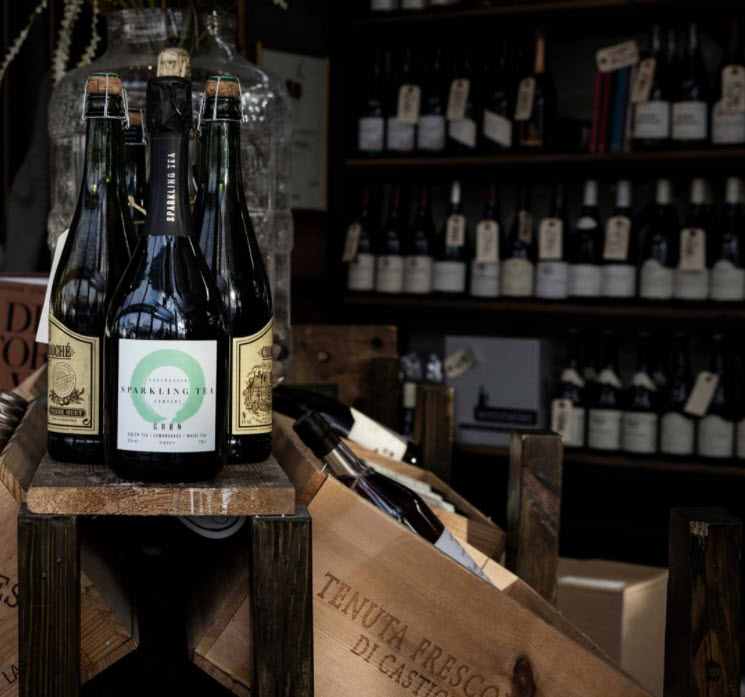
Sparkling Teas are Nicely Suited to Gourmet Dining
Jacob Kocemba, a Copenhagen-based sommelier credited with creating a new genre of low-alcohol teas has produced a range that’s elegant, contemporary and interesting.
It all started when Kocemba was head sommelier at a restaurant in his native Denmark. His head chef requested a wine to pair with a new dessert for the next day. It was a dessert that used an expensive French strawberry.
“In my wine cellar I had 1,700 wines,” says Kocemba, “but none of them matched the dessert.” He decided to step away and sleep on it. The next morning, there was still no wine he was happy with. So he went to the pastry chef, tasted each ingredient that was going into the dessert, then tasted them all combined. In a moment of inspiration, he stared for a moment at his tea shelf and saw many possibilities. That night he created a drink with tea that was an unexpected success that became special but not yet finished.
“Someone introduced me to carbon dioxide. I had every fifth weekend off, and started working with it,” says Kocemba. In 2011, a couple of years after his first forays into tea, Kocemba started the Kocemba Sparkling Tea Company. Three years later, he was back working as a manager in a Michelin-starred restaurant. But evidently, he could not leave the story of sparkling tea incomplete. So in 2016, once again, he quit his job to pursue his work with sparkling tea. In 2017, he partnered with Bo Stan Hansen to launch Sparkling Tea Co. in Copenhagen.
Kocemba talks about sparkling tea as one does of wine or champagne. It’s a category unto itself, with plenty going for it. But is it for the wine lover or the tea devotee? Both, says Jacob. “You will find a lot of links to the tea, you will recognize it as a tea drinker. Others will recognize the balance and sweetness and acidity, depending on what they are familiar with.”

The sparkling teas made by Kocemba are carefully crafted. Take for instance the BLÅ, a non-alcoholic tea, and one of the most popular teas in their range. It’s made with a whopping 14 teas, including an Earl Grey, the Lady Grey, a Fujian tea, both green and black teas from Assam, a Darjeeling, and an Indian jasmine tea — all organic and single-origin.
Each tea is extracted at different temperatures. “Just like champagne,” says Jacob.
Sparkling Tea offers two non-alcoholic and three alcoholic variations. Vinter is based on chai. Kocemba’s inspiration was Glögg. “In my opinion, it tastes like shit,” he confesses. But rather than dismiss it, he set to ask how he could translate the flavors into something drinkable. The result was Vinter, with the warm hit of spices from chai, that are joined by notes of bergamot oil from an Earl Grey.
Without doubt, Kocemba’s teas are complex. He uses from 6 to 13 teas to achieve the desired outcome. If white tea brings the velvety texture, green is sought for depth and umami while black tea lends a backbone to building layers. The blended teas are bottled with white wine or grape, chosen for their natural sweetness, and to enhance the flavors of the tea. A sparkling tea, is served chilled, in a champagne glass.
In 2019, Kocemba and Bo created a private label for the hallowed Fortnum and Mason. Jacob narrates an interesting story of how that came about. “One of the employees of Fortnum and Mason followed us on Instagram. He liked us. We were in London and wrote them a mail asking if we could drop by. They were stunned at how we look at tea.” Jacob created two non-alcoholic sparkling teas based on their teas, both still in production. The brand lists this as the most innovative product in their 300-year history!
It brought them attention and visibility, but Kocemba is not in a hurry to chase numbers. “We want to build this category,” he says. It is a difficult product to produce, evidently demands deep understanding of flavors and a lot of skill and precision. Jacob admits that it’s not an easy genre to propagate because of the craftsmanship it requires. At Sparkling Tea, he still makes all the bottles, with a batch taking 6-8 weeks to produce.
It is a category that offers plenty to both wine and tea drinkers. Adds Bo, “Both will experience a completely new and innovative way of enjoying tea, which broadens the use of tea and makes it relevant at even more occasions.”
Now, that ought to be reason enough to carry a bottle to the next dinner party.


Click to share this post with your pals.
Signup to receive Tea Biz weekly in your inbox.

